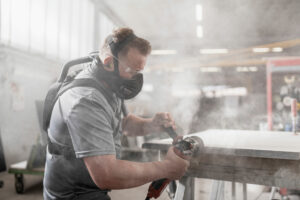Deadly Dust
Silica: Stealing Lives for Centuries

Optrel offers two top-tier PAPR systems, each uniquely designed for superior protection. Swiss-made for the highest quality, the e3000x and Swiss Air PAPR systems feature a TH3 HEPA filter for superior protection. (photo courtesy Optrel)
Approximately 2.3 million professionals face exposure to crystalline silica at work. In 2016, OSHA updated the exposure regulations for silica for the first time since 1971. Two years later, the National Institute for Occupational Safety and Health (NIOSH) reported on the largest cluster of black lung disease among active coal miners. A year later, California identified more than 70 cases of silicosis in countertop fabricators. Ten of those fabricators, between the ages of 30-40, died.
The situation is at an all-time high in L.A. County, where elected officials are considering a potential ban on selling and installing “silica-based engineered stone.” This substance, often called artificial or imitation stone, is composed of crushed quartz, made with up to 90% silica dust, held together with resin.
Are You at Risk?
Silica is everywhere. For most of us, it is harmless—a naturally occurring mineral found in sand, stone and other substances. For industrial workers, this seemingly innocuous substance is lethal.
The most common form of silica is quartz, found in granite, concrete and sandstone. Silica becomes toxic through various construction and manufacturing processes, including cutting, grinding, drilling and crushing materials (like stone, concrete and brick).
The dust released during this work, respirable crystalline silica, is 100 times smaller than a grain of sand, making it undetectable and easy to inhale. Once inside the body, the ultrafine particles reach deep into the lungs, causing irreparable damage, including:
- silicosis
- progressive massive fibrosis
- lung cancer
- coal workers’ pneumoconiosis (also known as black lung disease)
- and other debilitating, incurable diseases
Occupations at risk for developing respiratory issues, lung disease and silicosis include the following:
- Construction: anyone who engages in activities that require drilling, cutting or grinding materials containing silica, such as concrete or stone, is at risk.
- Coal mining: miners are often exposed to silica dust while extracting minerals from the earth.
- Sandblasters: workers using sand to clean surfaces often release a large amount of silica dust into the air, putting them at risk of inhaling the tiny particles.
- Quarry workers: those using heavy machinery to dig or drill stone, sand, slate and other materials from quarries and mines release silica dust into the air.
- Transportation: railway and roadway workers encounter silica in several ways, including ballast and sanding activities.
History Repeats Itself, Again
Silica dust has silently crept into the lungs of unsuspecting workers for centuries, cutting short the lives of countless workers. Below is an abbreviated timeline.
16th Century: Silicosis observed by German expert Georgius Agricola among miners.
1930s: “Hawks Nest Tunnel” industrial disaster in West Virginia. More than 750 workers died as a result of occupational exposure to silica dust.
2000: The U.S. government officially categorizes silica as a known human carcinogen, acknowledging its deadly impact on workers’ health.
2016: OSHA issues new silica exposure rules for construction, general industry, lowering the permissible exposure limit to 50 micrograms per cubic meter of air over an 8-hr shift
2018: Black lung disease surges among miners, with 400+ cases of advanced progressive massive fibrosis in Appalachia alone.
2019: Over 70 cases of silicosis reported in countertop fabricators in California. Ten men aged 30-40 died from the disease.
2023: The crisis continues worldwide, with California and Australia considering banning engineered stone.
A Modern-Day Tragedy Continues To Unfold
Take the story of Rodriguez, a 42-year-old worker, one of the first known individuals in the U.S. to fall victim to silicosis due to countertop work. Lured by a better paycheck, he changed jobs, never anticipating the dire consequences. By 2019, he was hooked up to an oxygen tank for six hours a day. Reflecting on his decision, he says, “That change ruined my life. It wasn’t just me. It was the whole company—that they don’t protect their employees.”
Imagine seeing your loved one come home every day covered in white dust. That was Victor. After work, he looked like he’d been in a snowstorm. Even his eyelashes were dust-filled. Most people would brush it off, thinking it’s just part of the job. But that dust was more dangerous than anyone thought. Victor went from a strong guy weighing 230lbs to only 125lbs in just two years. His body was ravaged by silicosis. As his wife Miriam recounts, “My mom still cries all the time, even now. And so do I. It is hard for us. A year has passed, but I feel like it happened yesterday. We cannot get over it.”
Silicosis Is Entirely Preventable

The Optrel Swiss Air is the most versatile PAPR on the market, it can be worn with a face shield, Clearmaxx grinding shield, or independent of facial protection. (photo courtesy Optrel)
In 2023, NBC spoke about silicosis with Arthur Frank, Professor of Environmental And Occupational Health at Drexel University. “[Silicosis] is an absolutely horrible, preventable, work-abusive situation that never should have occurred,” said Frank. The coverage also included input from Dr. Jane Fazio, a Pulmonary Specialist at Olive View-UCLA Medical Center, who co-authored a study about the rise of silicosis among young countertop fabricators in California.
If history is any guide, relying on government regulations or workplace standards to catch up with this modern-day health crisis is insufficient. Experts advise following the hierarchy of hazards control systems to help prevent exposure to occupational hazards.
1. Elimination
The best way to ensure safety on the job is to remove potential hazards completely. This is not always possible.
2. Substitution
When it’s impossible to eliminate a hazard, the next best course of action is to find a safer alternative. Opting for a less hazardous option reduces the overall risk; though similar to elimination, substitution is not always an option.
To mitigate the hazard of silica dust, OSHA’s 2016 amendment to silica exposure regulations includes the following engineering, administrative and PPE controls:
3. Engineering Controls
- implementing wet methods to reduce dust generation
- using local exhaust ventilation to capture and remove dust
- offering respiratory protection when exposures can’t be regulated to the permissible level
4. Administrative Controls
- Regularly measuring the amount of silica dust in the air
- Provide medical exams to highly exposed workers
5. PPE
- Wear respirators to filter out silica dust.
- Use protective clothing to prevent skin exposure.
While PPE is considered the last line of defense against workplace hazards, in work environments where silica dust is prevalent, it emerges as the singular element within workers’ control.
Protect Yourself and Prevent Silicosis
As we acknowledge past tragedies and confront present challenges, it becomes clear that change is necessary at all levels—from policymakers to employers and workers.
One of the best ways to protect yourself against silica dust is with a powered air-purifying respirator system (PAPR). While systems vary slightly by manufacturer, most PAPRs utilize positive pressure to filter the air through a facemask or hood. It’s important to note that facial protection is highly recommended when working in silica-laden environments.
As we move forward, it is our collective duty to learn from the past, act decisively and create a future where exposure to silica dust does not result in lives lost. The fight against silicosis is not just about compliance; it is about a commitment to worker safety, health and, ultimately, to preserving the invaluable human lives at stake. IHW
Share on Socials!
Respiratory Protection: OSHA’s 1910.134
More on Hearing Protection Training: A Deeper Dive into Standard 1910.95(a)
Protect Employees From Silica Exposure
Leaders in Industrial Hygiene
Council for Accreditation in Occupational Hearing Conservation (CAOHC)
Subscribe!
Sign up to receive our industry publications for FREE!








